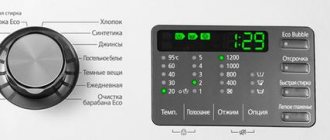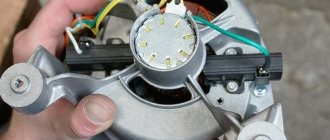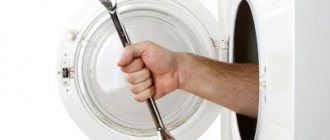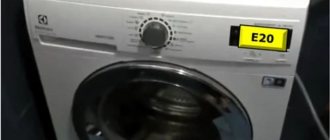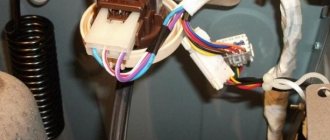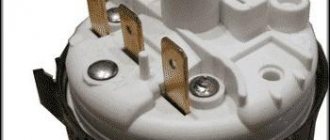Principles for determining the fault code
In cars equipped with an information display, it is not difficult to find out the error code - it will appear in bright yellow or green.
But if the model is less “advanced”, to find out the cause of the breakdown you will have to unravel the code programmed by the manufacturer, based on the prompts of the indicator lights.
Numerical values of indicators for calculating the failure code on the panel of a Hotpoint-Ariston washing machine that is not equipped with a digital display
Algorithm for determining a breakdown based on the light bulb signal:
- We remember the model of our Ariston machine (or check the information on the case or in the instructions).
- We remember which indicators indicate a breakdown.
- We find our device in the pictures.
- We determine the digital value for each indicator.
All that remains is to put the received data together and decipher the problem code.
The sum of the numerical values of the numbers of flashing lights on the panel of Ariston AVSL and AVL models will help decipher the code programmed at the factory
For example, if the lights corresponding to the values “2” and “1” are blinking on the washing machine, then you should look for the causes of the problems coded as F03 (or F3 , which is basically the same thing). Using this simple algorithm, other typical breakdowns are also determined.
Unlike most Ariston machines, in the AQUALTIS model internal problems are signaled not by washing modes, but by water heating temperature indicators
When the error code is clarified, all that remains is to determine the essence of the breakdown, and then decide whether it can be fixed with your own hands or whether it is better to immediately contact the experts.
How to determine the fault code - step-by-step instructions
In machines with a monitor, the cause of the malfunction is reflected on it in the form of an alphanumeric code. In older models, it is detected by the glow of indicators (washing modes, hatch blocking, etc.). For each error, a combination with an encrypted digital value is developed. To identify the cause of the malfunction, you need to perform the following steps:
Step 1. Determine the model of household appliances (look at the case or in the instructions for use).
Step 2. Remember which indicators were lit during the breakdown.
Step 3. Determine the digital fault code by checking the table in the instructions or on the manufacturer’s website.
Step 4. Check the table and eliminate the cause of the error, if possible.
Each washing mode on the front panel of the machine corresponds to numbers - 1, 2, 4, 8, 12, 16. If the indicators that correspond to the digital values 1 and 2 are lit, you need to look for error number F03 or F3. Do not forget that not all breakdowns can be repaired independently - sometimes it is better to contact a service center.
Attention! In different models, the indicators indicating errors are sometimes located in different places. Thus, in Aqualtis washing machines, failures are signaled not by washing modes, but by temperature indicators.
Table 1. Typical fault codes for Ariston brand cars.
| Error code | The problem it signals |
| F01 | Malfunction (short circuit) of the circuit that controls the drive motor |
| F02 | Tacho sensor or motor circuit malfunction |
| F03 | Temperature sensor error |
| F04 | Failure of pressure switch functions |
| F05 | Water supply/drain fault |
| F06 | Damage to UBL or control buttons |
| F07 | Failure of the heating element or pressure switch |
| F08 | Water heating relay malfunction |
| F09 | Machine memory (firmware) failure |
| F10 | Lost water level sensor signal |
| F11 | Failure of the pump responsible for draining water |
| F12 | Lost connection between the electronic controller and the display module |
| F13 | Malfunction of the drying temperature sensor |
| F14 | Drying fault (does not turn on) |
| F15 | Drying fault (does not turn off) |
| F16 | For vertical machines - an error in the operation of the drum. Models with horizontal loading do not have a code. |
| F17 (sometimes referred to as DOOR) | The door is open or does not seal against the rubber rim |
| F18 | Microprocessor failure |
| H20 | Incorrect water supply |
Video – All error codes + error indication without display
Problems with the motor or control board
If you have loaded things into the device compartment, turned on the appropriate mode and pressed the “Start” button, but the drum does not rotate, most likely the problem lies in the operation of the motor or control controller, which the display will signal to you with code F1 , F2 or F18 . Although such breakdowns can occur at any other stage of washing, they are most often displayed precisely at the start of the program.
Irregularities under code F01 (F1)
Error F01 indicates problems in the control circuit of the motor that drives the drum of the washing machine. If there is no response to a signal from the electronic controller (board), the device will not work, and when you try to switch to any other program, it will continue to persistently display a fault code.
The causes of failure of the motor control module with code F1/F01 are most often problems with the voltage in the electrical network or high humidity in the room
Self-fix process:
- A universal option for any codes is to unplug the washer from the outlet, wait 10-15 minutes and turn it on again - there is a chance that the electronics will reboot and stop giving an error. But even if everything worked out and the device started working, it is worth taking precautions so that the “first sign” does not lead to serious damage.
- F1 signal can be triggered by a decrease in network voltage (below 200 V) or a sharp jump, as well as damage to the plug or bending of the power cord. Try not to turn on the washing machine at the same time as other powerful energy consumers or through an extension cord, because ideally this device needs a dedicated line with its own machine.
- Inspect the cord, the plug and the outlet itself - perhaps the reason is their malfunction.
- High humidity in the bathroom can also cause problems with the motor control circuit. Remove moisture from the board contacts and ventilate the room often so that the humidity level does not exceed 70%.
- The cause of the error may also be a disconnection of contacts in the engine control circuit. If you have skills in working with electronics, you can independently check the circuit from the device motor to the board for the quality of the connections by ringing with a multimeter all areas that cause suspicion.
If independent repair attempts do not lead to a positive result, the reason may lie in a breakdown or failure of the control board firmware, erased electric motor brushes, a burnt out motor winding, or damage to the cable with wires. To restore or replace these parts, it would be better to contact a service center.
Decoding signals F02, F2
This error most often occurs at the start of the program or at the spin stage, when the machine picks up speed to spin the laundry (at the same time, the drum itself may twitch or rotate intermittently). The device will display code F02 and at the same time begin to drain water.
Typically, this signal indicates a malfunction in the motor circuit or a breakdown of the tachogenerator - a small part with a ring that controls the speed of the washing machine engine.
To inspect the tachogenerator, you will have to partially disassemble the device, get to the engine and find a metal ring with wires on its shaft
Solution to the problem:
- If the machine displays an error for the first time, the cause may be a one-time failure in the operation of the electronics due to network surges. Disconnect the device from the power supply for 10-15 minutes to allow the equipment to reboot.
- Check that the drum itself is not blocked - it should turn freely by hand. But if during washing a small object gets between the drum and the tub, the culprit of the breakdown should be carefully removed and the machine restarted.
- Problems with contacts - it is necessary to check the serviceability of the connections from the board to the electric motor, including the section with the tachogenerator.
But error F2 can also be a consequence of more serious failures, the elimination of which will require replacing the motor, tachogenerator or control board. In such cases, it is better to contact a workshop; you may be able to get by by replacing faulty solders on the control module or restoring damaged wiring.
Communication or board memory error with codes F09, F18
A signal about a malfunction of the electronic controller under code F18 can only be issued by Aristons with an asynchronous motor (models Hotpoint-Ariston, Margherita, AVSL, AV, AVL, AVTL, CDE); such errors do not occur on devices with a commutator motor.
The controller is an electronic board that is responsible for selecting the washing mode and displays it on the display, gives commands to the intake and drain valve, pump, pressure switch and controls the operation of the engine
Signs of controller malfunction:
- Incorrect engine operation - sudden changes, too high or, on the contrary, unreasonably low revolutions.
- The drum does not rotate when starting the washing mode.
- Spin does not work.
- The machine fills with water and immediately drains, displaying a signal about damage.
F09 – a memory error can occur when the network voltage surges or decreases. But it may also indicate a failed control unit.
The first action after displaying codes F09 and F18 is identical to previous problems - turn off the power to the machine, give it time to reboot and turn it on again. If the reason is not a failure, it is necessary to check the board microcircuits.
But if you do not have the skills for such repairs, you need to entrust it to professionals who can reflash the controller, solder the contacts, replace only some elements (for example, the power capacitor) or replace the entire board
How to decipher an error code in Ariston without a display by flashing indicators
The indicators on the Ariston SMA control panel have their own numerical values. To find out the code that the machine is signaling, you need to add up the numbers of flashing indicators. Below are the most commonly encountered control panels and the meanings of their indicators.
Hotpoint-Ariston washing machines of the Low-End line: models ARSL, ARXL, AVM, BHWD, BHWM, ARTL, ARUSL and others
Ariston car models AVL, AVTL, AVSL, CDE and others
Hotpoint-Ariston AQUALTIS washing machine models
To determine the error code in your Ariston, you must:
- find a control panel similar to yours in the photos above;
- record or photograph which lights are blinking;
- “translate” the flashing indicators into the numbers corresponding to them and sum them up.
Example! Let's say you have an Ariston AVL 100 model. The spin indicator and the lowest button for additional functions (to the right of the spin) are blinking. We get in numbers: 16 and 1. The sum is 17. Thus, the Ariston washing machine shows error F17. In the code table we see that F17 is a washing machine door error.
You can read what the error code means in the “Ariston and Hotpoint-Ariston washing machine codes” section.
How to determine the error code in Ariston Margherita washing machines
One of the oldest Ariston models is Margherita. It reports problems by flashing the power indicator (also called the “on-off” indicator). To find out the error code, you need to count the number of short flashes of the light bulb. This will be the error number.
Example! Your Ariston Margherita blinked 3 times in a row, followed by a pause. And again 3 blinks. This means we are looking for error F3: using the code table. This is a temperature sensor error.
As you can see, determining the error code in Ariston machines without a display is not at all difficult. The same cannot be said about eliminating it. If you don't want to risk your SMA, it's best to seek professional help. Call RemBytTech:
+7 (495) 215 – 14 – 41
+7 (903) 722 – 17 – 03
Or submit an online application.
Our technicians have many years of experience in repairing Ariston and Hotpoint-Ariston washing machines. They will fix yours too! We arrive quickly: within 24 hours from the moment you contact us. Departure is possible every day. We repair equipment at home, in one visit. We provide a guarantee for work and new spare parts for up to 2 years. Contact us!
Rate this article: 4.9 1 5 8 votes (average 4.9 based on 8 votes)
Problems with water heating
If during the washing mode the washing machine freezes for a long time, stops, does not heat up, or constantly drains water, the causes of the breakdown should be sought in the heating circuit. The device will signal these problems with codes F04 , F07 or F08 .
Failure of the heating element or pressure switch and codes F04, F07
In washing modes where heating is required, the error may appear immediately after startup, or after drawing water, but rinsing or washing in cold water will work normally. In this case, there are several options for solving the problem (besides the standard turn on/off the machine to reboot the controller).
If the code appears on the display during the washing phase or during startup (the machine does not even want to draw water), most likely the reason lies in the heating element itself. It can “pierce” onto the housing when the contacts come off or simply burn out.
To fix the problem, you need to get to the heating element, check all its connections, change the resistance with a multimeter (with a power of 1800 W it should produce about 25 Ohms).
To replace a faulty heating element, disconnect the cable with wires, unscrew the fastening nut (1), press on the pin (2) and pry off the sealing rubber (3), then install a new part and reassemble in the reverse order
If the device collects and then immediately drains water, the cause may be a breakdown of the pressure switch - the water level sensor. If there is a problem, this element can provide the controller with information that the heating element was not immersed in water, which is why the machine does not start heating.
In this case, it is necessary to check the water pressure sensor tube with the pressure switch (the hose may become clogged, kinked, frayed, or come off). At the same time, inspect the contacts of the sensor itself - they may need to be cleaned. But more precisely, code F04 - most likely, the part will require replacement.
To check the operation of the pressure switch, you need to put a small piece of hose with a diameter identical to the removed tube onto its inlet fitting and blow - characteristic clicks will be heard from a working part
In some cases, the problem may be in the board itself, faulty wiring or contact groups in the area from the board to the heating element or water level sensor. Therefore, you should ring all the elements of the control unit associated with the operation of the heating circuit, and if necessary, replace the burnt tracks or the controller itself.
Heating circuit faults and F08 symbol
If the water heating does not work correctly (or the machine “seems” that it starts when the tank is empty), error code F08 . The cause is most often a malfunction in the pressure switch circuit.
This problem can occur due to high humidity in the room, which negatively affects the controller. To make sure the board is in order, inspect it, wipe it dry, or blow it with a hairdryer.
Another simple solution to the issue could be the disconnected contacts of the heating element and the pressure switch, especially if the device was started for the first time after transportation. In other cases, a more professional inspection will be required with possible replacement of parts.
First, make sure that there is really no water in the tank, then remove the back panel of the machine and check the heating element with a tester
Possible malfunctions of Ariston machines, indicated by code F8:
- If the washing mode is interrupted immediately after starting or during the washing phase and the device does not heat the water, the heating element will most likely need to be replaced.
- If the machine stops after starting, when switching to the rinsing mode, or does not spin, it is possible that the contact group of the heating element relay is “stuck” on the controller when it is on. In this case, you can replace the failed elements of the microcircuit and, if necessary, reflash the board.
- If the device “freezes” in various modes (and this can be either washing, rinsing or spinning), the wiring or contacts in the heater circuit may be damaged, or the pressure switch may break down, which considers that not enough water is entering the machine.
But if, when checking all the connections of the circuit and separately the pressure switch, the heating element relay and the heating element itself, no damage is detected, you will have to change the controller.
Errors in the operation of the drain or water intake
If the machine cannot draw water or, on the contrary, stops working, although its tank is full, codes F05 , F11 or H2O . Let's try to understand the essence of such breakdowns.
Drain violations and codes F05 or F11
Error F05/F5 always lights up when the drum is full, but attempts to force drain it remain unsuccessful - the machine “does not release” water and continues to signal a breakdown.
In this case, a cracking noise may be heard, as if some foreign object had hit the fan impeller, or a humming sound from the pump. Such a breakdown is a fairly common occurrence with Ariston machines, and in most cases you can fix it yourself.
Most often, the problem lies in a banal blockage of the drain filter or drain hose - when washing, various hairs, threads, buttons, particles of dirt and small debris are separated from things, which gradually clog the gap for water to exit.
To remove them, you need to manually drain the water through the filter (if it is not the hose that is clogged) or manually scoop out the drum.
If the machine has blocked the doors and the water does not drain through either the filter or the hose, you can remove the liquid by unscrewing the drain pipe
Then check the condition of the drain filter (small hatch at the bottom of the machine), the pipe itself, and rinse the hose under good water pressure. At the same time, inspect the siphon or pipe if the drain is organized directly into the sewer.
Then reassemble the system in the reverse order, turn on the machine to the rinse program, make sure that it has filled with water, and forcefully switch to spin - if error F05 does not appear and the drain works, then the problem is solved.
To avoid breakage, wash wool and fur items in a special bag, be sure to check the pockets of clothing before loading and arrange a preventive inspection of the filter at least once every two to three months
If the problem is not a blockage, the following options are possible:
- Failure of the drain pump/pump - the part may simply require replacement, having honestly exhausted its service life, or it may fail due to the penetration of a foreign object, a broken motor coil, or a short circuit. First, you should disassemble the pump, remove debris, check the chain and try to start the machine again. If the problem persists, you will have to replace the filter.
- Malfunctions in the operation of the electronic controller - the corresponding tracks or radio components on the microcircuit may burn out or oxidize (most often due to the same high humidity), or a firmware failure may occur.
- Failure of the pressure switch - if the sensor provides information that the tank is empty, the machine simply will not start the draining program, so the faulty part must be replaced.
- Wiring problems - you need to check if there is power to the drain pump when it is turned on.
Similar problems can occur with error F11 . Although most often this code indicates a breakdown of the drain pump (this is where the inspection should begin), it can also be due to incorrect operation of the pressure switch, controller, or damaged wiring.
Problems with water intake and H2O code
Another common error, familiar firsthand to owners of Ariston machines, is the H2O , which indicates problems with the water supply. Usually it occurs 5-7 minutes after start (in rare cases - during rinsing), and the device may not let in water at all, or may collect too much of it.
The water supply error is perhaps the only one that is intuitive among other codes, since it is associated with the chemical formula H2O
Sometimes the H2O can appear chaotically in different programs, but its characteristic feature is that the drain and spin modes always work flawlessly.
The H2O code is often issued when the fill valve mesh is clogged, so you need to remove it with pliers and thoroughly rinse the cells under water pressure
Possible causes of failure:
- Lack of water in the water supply, insufficient pressure or the supply valve to the device is closed. The actions here are clear: open the tap, wait for the water supply to be restored.
- Damage to the water intake valve, which “allows” water into the device - if it breaks, it is easier to replace this part with a new one than to try to repair it.
- Malfunction of the pressure switch - if the hose is clogged or damaged or the sensor itself breaks down, the machine will constantly draw in and immediately drain water, displaying the H2O .
But if all the elements work, the problem may be a signal break due to damaged wiring or failure of the electronic controller.
Other errors and their interpretation
In total, Ariston machines have 19 code signals indicating problems, of which we have examined the most common ones.
But let’s briefly talk about other possible malfunctions in the operation of equipment:
- F03 – temperature sensor failure. You need to check the resistance of the sensor itself (normally about 20 ohms), as well as the circuit to the controller. If necessary, replace damaged parts.
- F06 - indicates a problem in the circuit of the hatch locking device for Ariston cars on the Arcadia platform (Low-End and Aqualtis series), as well as problems with the control buttons for Dialogic models. In the first case, you should see if any item in the load is preventing you from slamming the door until it clicks. In the second case, the problem may be with sticking buttons or damaged contacts.
- F10 – no signal from the water level sensor. The device can generate such an error if the drain is connected incorrectly to the sewer, there is insufficient water pressure, or there is an open circuit from the sensor to the board.
- F12 – lack of communication between the controller and the display module. If rebooting does not help, you need to check the control board, display unit and their connection.
- F13 - an open circuit or breakdown of the drying temperature sensor will require replacement of a part or worn contacts.
- F14 or F15 – malfunction of the drying heating element or an open circuit in the heater circuit.
- F16 – signal for machines with vertical loading that the drum lock sensor is broken. Most often it happens due to simple inattention - for example, the doors are not closed until they click. In other cases, the reason may be weak contacts in the section of the circuit up to the board or failure of the sensor itself.
- F17 or door – “indicates” that the hatch is not closed tightly enough. Perhaps the problem lies in an intruded foreign object, a weak hinge fastener, or a dirty lock for the door “tongue”. If no external culprits are identified, most likely the device that blocks the door while the machine is operating is faulty and should be replaced.
And in any of the options, the rule applies: in addition to the specific part that the device “indicates”, the breakdown may lie in a faulty board, damaged contacts or non-working wiring.
Description of error codes and troubleshooting methods
Most Ariston appliance users choose washing machine models equipped with a display. The following table lists the error codes, what causes them, and possible troubleshooting methods.
| Error code | Description | How to diagnose and fix a problem |
| F01 | There is a short circuit in the electric motor circuits | Avoid getting moisture on the contacts of the electronic controller. Check the serviceability of the control triac and motor, replace parts if necessary |
| F02 | There is no tachometer signal to the electronic controller | Make sure that the contact circuit between the drive motor and the controller is reliable. Measure the resistance of the tachometer winding (the norm is 115-170 Ohms for EVO-I series machines). Avoid rotor blockage (for example, due to bearing failure). Replace the motor, tachogenerator or control unit (depending on the identified breakdown) |
| F03 | The temperature sensor is broken or the heating element relay is jammed | Check the integrity of the contacts between the specified sensor and the controller. Determine the electrical resistance of the temperature sensor (it should be 20-22 kOhm at 20 ℃). Replace sensor or electronic unit |
| F04 | The pressure switch (water level sensor) is faulty | Test the level sensor with a multimeter and check the electronic connections between the control panel and the level sensor. Install a new pressure switch or electronic controller |
| F05 | The operation of the drain system is disrupted; the level sensor does not give an “Empty tank” signal after the end of the drain mode | Remove blockages in the drain system (filter, hose, pump). Check the integrity of the connections between the drain pump and the control unit. Measure the voltage at the pump contacts at the time of its intended start. Make sure that the level sensor and its connections to the electronic controller are in good condition. After determining the breakdown, replace the pump, pressure switch or electronic controller |
| F06 | A button error has occurred (for AD series machines - Ariston Dialogic) | Check the functionality of the buttons on the control unit. Make sure there is no contact in the connectors between the controller and the control panel. Replace faulty parts |
| F07 | There is a malfunction in the heating element or level sensor (after adding water to the tank, the heating element cannot produce heating) | Inspect the electrical circuits and connections, the heating element relay and the electronic controller (in EVO-I series machines) for damage. Use a multimeter to test the water level sensor, electrical contacts and heating element (with a heater power of 1800 W, the resistance should be about 25 Ohms) |
| F08 | A simultaneous message from the pressure switch “Tank empty” and “Tank full” appeared, the heating element relay jammed | Check the heating element and its relay, water level sensor, controller and all electrical connections between these elements. Replace faulty parts |
| F09 | There is a problem with the contents of volatile memory | Rewrite the volatile memory chip or completely replace the electronic controller |
| F10 | Error signals are received from the level sensor (the tank is not full and not empty) | Inspect the connector contacts between the electronic unit and the level sensor for integrity of connections. Test the performance of the pressure switch. Replace controller or level sensor |
| F11 | There is no data on the operation of the drain pump | Check contacts CNF and CN1 (for machines of the EVO-I series), operation of the pump and pressure switch. Make sure that the contacts and terminals of the electronic panel and the connection circuit that leads to the pump are in good condition. Replace the pump, controller or pressure switch |
| F12 | A communication error has occurred between the display unit and the controller | In cars with the EVO-I system, examine the condition of the controller and its connections. In EVO-II series models, use a tester to ring terminal J11, the entire display unit and the controller |
| F13 | The drying control system has failed (for Margherita 2000 models on the EVO-I system) | Measure the performance of the controller and temperature sensor. Check CAN connector and contact circuits |
| F14 | Drying defect detected | Look for a malfunction in the operation of the controller, heating element and connection circuit |
| F15 | There was a drying failure, the heating element does not turn off | Determine the reliability of the connections between the drying heating element and the controller. Make sure the connection board and water level sensor are in good condition |
| F17 | The hatch door was detected as not being closed. | Make sure that the door is pressed well against the drum. Check the door lock for serviceability. Measure the alternating voltage between pins 1 and 3 on connector M (in the OFF STANDBY position), as well as between the named contacts of the locking lock. Install a new lock or controller |
| F18 | A microprocessor error has occurred | Replace the electronic unit |
The combination of symbols H20 in an Ariston machine means problems with water intake.
As you can see, after deciphering the code, most of the problems can be fixed on your own, and only some problems may require the intervention of a specialist. Difficult cases are usually associated with electronics, for example, error F12 in an Ariston washing machine. We hope that in the article you will find answers to your questions and make the right decision to restore the operation of the unit.


